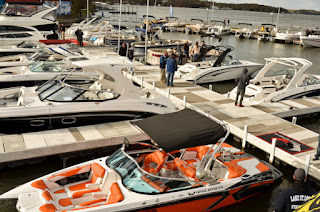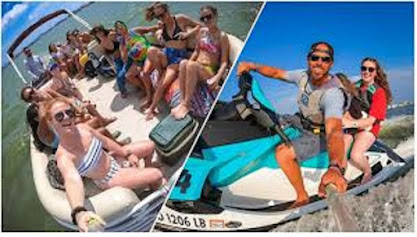Circle of Death
The basic problem of unmanned boats going in circles (the Circle of Death) has been known a long time. The earliest example we have found was reported 14 July 1935 in the New York Times. Two young men on the Potomac River were ejected, the boat began to circle at full throttle, they dove repeatedly to try to escape to boat and propeller, one was eventually struck in the head and drowned, the other was struck in the shoulder.
By the early 1950ʼs boat kill switches of multiple designs were used in National Outboard Racing Association boats.
George Horton, of Fort Worth Texas, applied for a patent on his “Quick Kill” recreational boat kill switch on 29 November 1972. He received U.S. Patent 3,786,892 on 22 January 1974, and entered productions with the “Quick Kill” kill switch in August 1974. His switch is widely viewed as the first commercially available kill switch designed specifically for use in recreational boats, vs. the earlier racing designs.
In October 1973 Vernon Fowlkes, a supplier to the bass fishing and bass tournament industry from Tulsa Oklahoma, was killed during the 1973 Bassmaster Classic III tournament in South Carolina. As part of a group of celebrities at the tournament, Fowlkes, a sportswriter, and a local bass fisherman were headed back for the weigh in, the steering cable broke, the boat ejected all three men, circled, and the propeller fatally struck Mr. Fowlkes. Ray Scott, the well known bass tournament promoter, is said to have created a rule requiring all bass boats used in his tournaments to have a kill switch as a result of this accident.
In August 1974, Popular Mechanics published an article titled, “This Switch Can Save Your Life: Now Required for Racing, and Tournament Fishing. This is Boatingʼs Newest Necessity”, assailing the features and benefits of Mercuryʼs Quicksilver Ignition Stop Switch.
The issue of using kill switches as a means of stopping runaway boats was raised as a member item at U.S. Coast Guard (USCG) National Boating Safety Advisory Council (NBSAC) Spring 1976 meeting.
July/August 1975 Boating Magazine letter to the editor wonders why the Coast Guard Office of Boating Safety failed to mention kill switches in their response to a letter in May. The current commenter talks about runnaway boats coming at those who fell overboard in ever decreasing circles, says kill switches are required in bass fishing tournaments, and are sold by many marinas.
1978, 1979, and 1980 saw the Valerie Bailey v. Boatland of Houston trial and its appeals. Bailey v. Boatland was one of the first cases against the industry for injuries allegedly caused by their failure to install kill switches. Sam Bailey was killed on 27 May 1973 at Lake Livingston (Texas) in an accident involving a circling 16 foot bass boat that was claimed to be defective because it did not include a kill switch. Much of the litigation centered on timing (date of building the boat, date of the accident, date of invention of kill switch, date kill switches for recreational boats became commercially available). The boating industry won the case in the trial court, lost the first appeal, then won again in Texas Supreme Court. The Texas Supreme Court took a hard line on commercial availability of kill switches for recreational boats vs. easily adapted from racing boats or other applications. There was also some discussion of the responsibility of the dealer (Boatland) vs. that of the manufacturer during the trials.
1979 Alabama passed a law requiring the mandatory use of kill switch lanyards on certain boats.
All boats must be equipped with some type of emergency ignition cut-off device (kill switch) on any remote steered outboard while the main engine is in use. ... However, kill switches are not required with hand-operated engines unless equipped with one when manufactured.
At last count, 46 states or territories have rules for cutoff switches on personal watercraft. This makes it seem that risks are greater on a PWC than on an open motorboat.
However, there is no requirement by federal law that all operators must use the cut off device. it is currently up to each state to enforce the mandatory use of the kill switch. There are 7 states that mandate with enforceable laws the use of a kill switch. They are: Alabama, Texas, Arkansas, Louisiana, Illinois, Nevada, and New Jersey.
Be safe, even if your state does not have a mandatory use law, just like a life jacket wear it. it will save a life.




Comments
Post a Comment